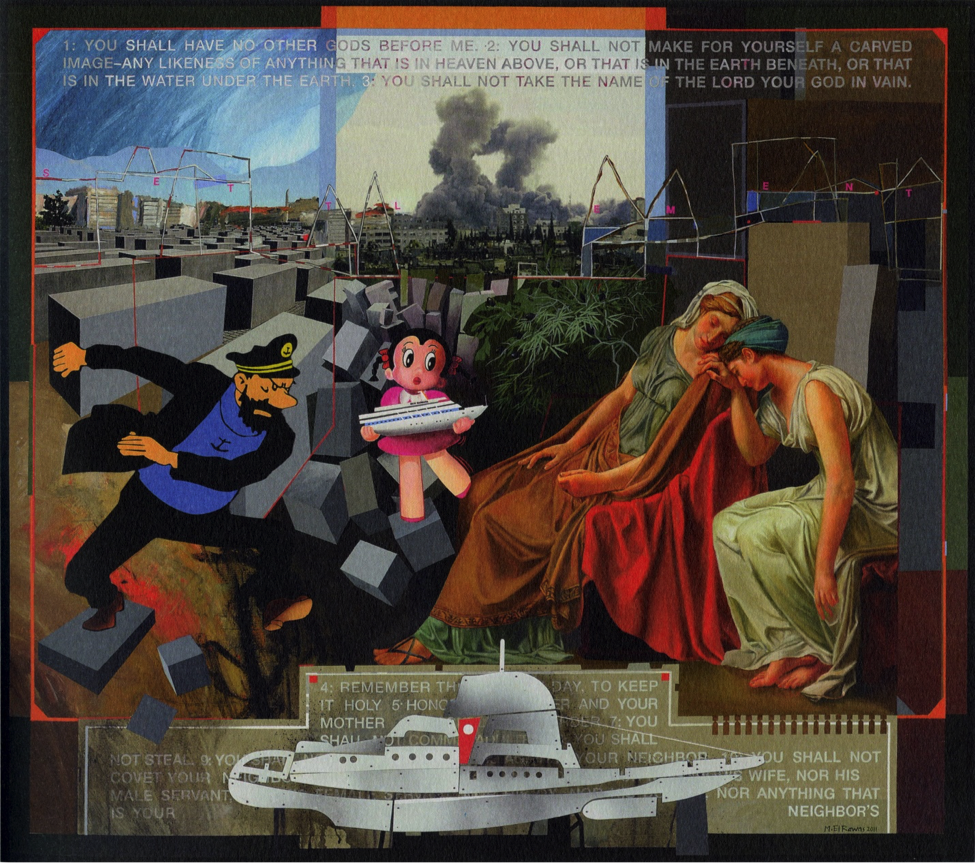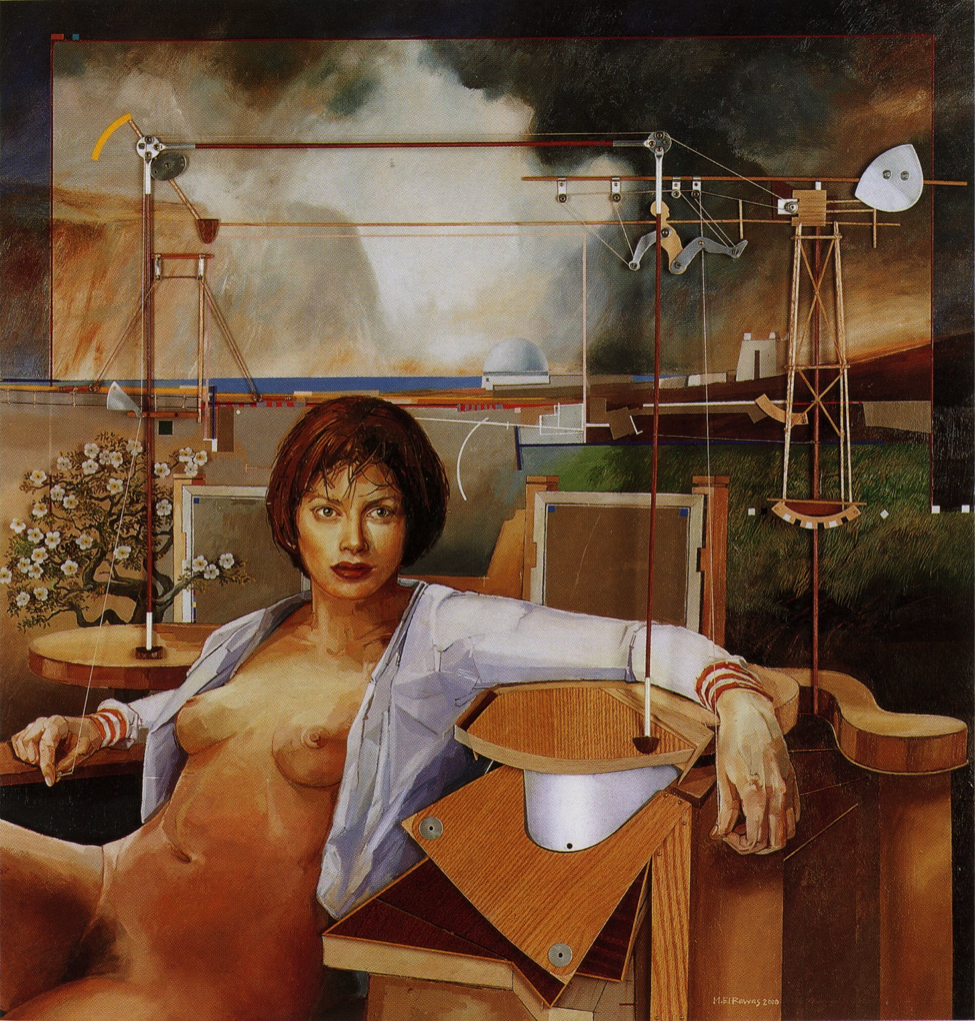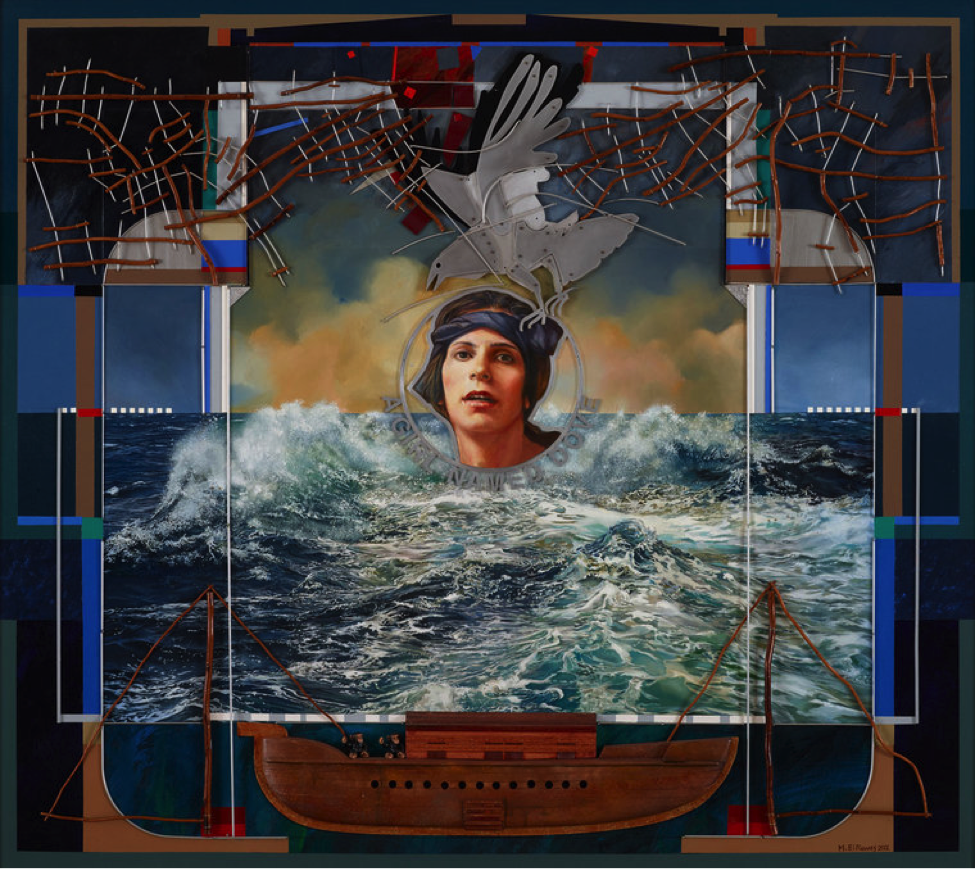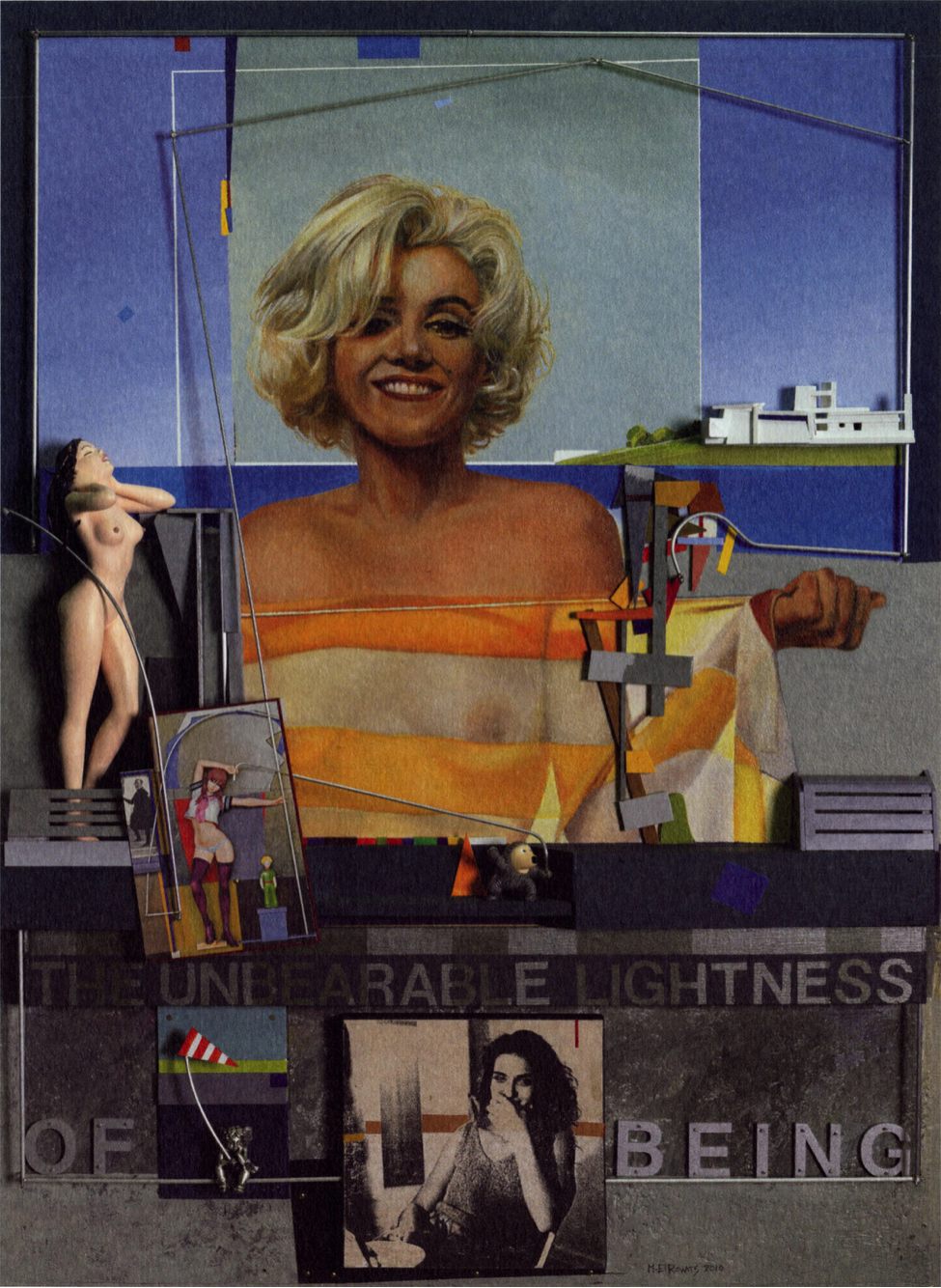Introduction
Mohammad El Rawas is a renowned modern and contemporary Lebanese artist, known for his printmaking, paintings, sculptures and assemblages. In my article I will be focusing on El Rawas’s assemblage art. Assemblage is an artistic phenomenon that blurs the genres and boundaries between mediums and objects. At its core, it is an avant-garde approach to the creation of art that aims at challenging media specificity by arranging various objects, paintings, and three-dimensional objects into new combinations. El Rawas’ approach to assemblage art is unique in two ways: it pushes the boundaries of art in terms of form, and offers sharp critique of culture in terms of content. This article explores El Rawas’s career, artistic output and, in particular, the assemblage phenomenon as approached by El Rawas, and how he brings various themes together within his work.
Output Through Tribulations
In 1975, the Lebanese Civil War (1975 – 1990) had erupted just as El Rawas completed his Bachelor’s degree in Painting at the Lebanese University. The violence affected El Rawas, as it did many other Lebanese, and he moved first to Damascus and then to Morocco, where he took up a teaching post in Rabat.[1] The change of scenery and the distance from the upheaval of war gave El Rawas the space to return to painting. During this period, he would begin experimenting with new ways of approaching art, “either by creating a new and innovative pictorial solution to the problem of representing reality […] or by adapting the medium of art to the expression of ideas, directly or indirectly, as in the majority of modern conceptual art movements.”[2]
El Rawas would then move to London to complete his Masters in Printmaking at the Slade School of Fine Art. As a theme or subject matter, he would tackle the war as a subject, without being overtly symbolic in his depictions: for instance, his work never showed elements such as blood, dead bodies, and/or a fist of resistance. In fact, this type of imagery never appears in his work.[3]
In 1981, after he completed his Master’s degree, he returned to Lebanon. There, he would switch to a different set of subject matter, particularly in relation to war. Being away from danger gave him the luxury to tackle it as a subject. But once within the realm of war, art became an escape for him to tackle different topics.[4]
His work would continue to address brutality and was imbued with dark humor and existential questionings long after the war ended in 1990. This questioning, for him, is continuous, as there are no harsh lines between the war, before the war, and after the war; ideas take time to brew.[5]
Assemblage and the Crux of El Rawas’s Method
Assemblage is artwork that is created by putting together and manipulating found objects and cut out paper along with painted surfaces; it can be two or three dimensional in its medium.[6] The assemblage phenomenon surged in the postmodern period, with works such as those by Robert Rauschenberg in the 1960s. Robert Rauschenberg participated in The Art of Assemblage exhibition in 1961 at the MoMA.[7] His assemblage First Landing Jump, 1961, combines painting with found objects, including cloth, metal, leather, electric fixture, cable, a wooden plank, and an automobile tire.[8] Design guides the configuration of all the different elements. El Rawas has his own distinctive approach to the assemblage, one that has become synonymous with his name in the local art scene.
Across El Rawas’s assemblages there is a wide array of references and allusions. This forces the viewer to engage with the work intellectually, rather than solely visually or aesthetically. The artworks are complex, but each piece comes together in its design, layout, composition, and color scheme. El Rawas affirms that the reaction and sensation to a 2-dimensional artwork is not the same as that to a 3-dimensional artwork. The practice began with his first assemblage in 1987 titled The Lady Who Descended the Staircase, a small work of only 18.5 by 18.5 centimeters. The artist experimented with the materiality of the artwork as well as the addition of 3-dimensional objects, such as cardboard, to the surface. The practice started then and developed into an interesting and, as he states, ‘enjoyable’ practice that has remained in his oeuvre until date.[9]

Figure 1. Mohammad El Rawas, 2011, Till Death Do Us Unite, copyright Mohammad El Rawas
Till Death Do Us Unite, 2011, is a prime example of El Rawas’s assemblage art. The work alludes to the Israeli occupation and the Israeli-Palestinian conflicts. The painting’s visual elements are symmetrically distributed in terms of composition: a rectangular frame is painted within the inner surface of the square canvas, drawing the viewer’s eye into its confines. The painting has a tripartite composition, including a foreground, middle ground, and background. At the top of the main rectangular frame is an inscribed text from the Old Testament, with excerpts from the Ten Commandments, written in sans serif lettering. Outside of the main frame, on the bottom register, we see the continuation of the text, this time with a sand color background, and an abstracted representation of a submarine superimposed above it.
The horizon line in the background is above the center of the painting’s composition. It divides the canvas at the upper register, allowing for the sky and making room for the previously mentioned inscribed text. The artist paints the sky in the upper left register in three pastel blue tones, while at the horizon, he superimposes a cut out photographic image picturing the bombing of Gaza by Israeli forces. In the middle ground, El Rawas depicts an abstract representation of the Holocaust memorial in Berlin, along with rubble extending into the foreground, functioning as stepping stones for the two cartoon-like characters there.
The machine at the front of the piece provides a striking contrast between organic materials and geometrical elements, and adds a mechanical dimension to the assemblage. All the formal aspects of machines – their regular shapes, smooth surfaces and reflective qualities – contrast intrinsically with organic materials and the flesh of figurations.
In the foreground we see three main elements, borrowing from different sources. On the right, two women drawn from Jacques-Louis David’s painting The Oath of the Horatii, 1784, are shown mourning. They are painted in the Neo-Classicist style, with chiaroscuro technique (high contrasts between light and shadow), but using a more varied color palette than the original painting. In the original painting, the Horatii brothers pledge allegiance to Rome as they prepare to wage war against the Curatii;[10] the women are relatives of the men and mourn their impending doom. In the context of the El Rawas painting, the two women may either be relatives on both sides of the Israeli-Palestinian conflict, or are both simultaneously mourning Gaza.[11]
The figure on the left is Captain Haddock, from the comic book series The Adventures of Tintin. The character appears in a rage, balancing his footing on the rubble, which is tumbling forward from the Holocaust memorial in the middle ground. The character is painted in the same style as the comic-strip aesthetic, with flat areas of color. Similarly, in the center is a Japanese cartoon character called ‘Uran’ from the Astro Boy manga series by Osamu Tezuka. She appears to be rushing forward to the viewer, carrying a model ship of the Mavi Marmara, the Turkish ship which was bringing aid to Gaza in May 2010, but was struck by Israeli forces.[12]
Thus, the three visual references in the foreground stand for grief, rage, and hope. The different elements in the artwork come together to forcefully drive the message of the brutality of war. As the artist states, “despite the divine call for honesty, truthfulness and peace among mankind as stated in Moses’ Ten Commandments, wars and fighting will persist,”[13] until the end of times.

Figure 2. Mohammad El Rawas, 2000, The Amusement Park, copyright Mohammad El Rawas
Another assemblage piece is The Amusement Park, 2000. The nude model subject is actually composed from three different sources. The position is derived from a painting by Euan Uglow, the body from an adult entertainment magazine, and the head from a photograph of model/ actress Christina Mackmenanie. The nude is the centerpiece of the work, surrounded by landscapes, a small still life and a mechanical configuration[14].
The work is, atypically, an open composition. The nude woman’s body extends out of the limits of the canvas on the left, while her gaze seems to focus beyond the canvas in the opposite direction. She occupies almost the entirety of the foreground along with the supporting structure, which appears fragmented. Her head is below the horizon, and a vast landscape constitutes the background area. The still life to the left and the mechanical object to the right make up the middle ground, and in a way, frame her. She is the focal point of the work. Even the tonality and color scheme of her nude body is repeated in the fragmented wooden structure that supports her and also subtly in the background and skyscape.

Figure 3. Mohammad El Rawas, 2012, The Dove and the Crow, copyright Mohammad El Rawas.
The Dove and the Crow, 2012, is more centralized than the other two. All the chosen assemblage elements within this work revolve around the theme of Noah’s Ark. It is a closed composition, with a tripartite vertical arrangement and the horizon level almost at the center of the artwork. The horizon also serves to divide the artwork visually. The side parts of the triptych contain frames, rendering the artwork almost like a folding religious panel. The focal point of the artwork is the facial portrait of ‘A Girl Named Dove’, which is a reference to the actual dove from the story. Dove’s head is surrounded by a ring with lettering, which is carried by the ‘crow’, which is depicted in an abstract style using aluminum panels. The realism of the ‘Dove’ portrait contrasts with the abstraction of the ‘crow’ representation. Furthermore, these two characters are placed almost exactly at the center of the composition.
Another stark contrast emerges: the vast area of the ocean in the middle ground is painted in oil in a hyper-realistic style, while the wood and aluminum parts in the upper register are placed in an almost haphazard arrangement. At the bottom register is a simplified representation of the Ark; it is simple in form but accurate in terms of the wooden texture. Conclusively, the work is united in theme, but variable in aesthetics.

Figure 4. Mohammad El Rawas, 2010, The Lightness of Being, copyright Mohammad El Rawas
Absurdity Across the Assemblages
El Rawas tackles the theme of absurdity in his assemblage work in a manner that highlights his sense of cynicism. He claims that every time he creates a work of art, it has some absurdity in it as a reflection of the haphazard realities of life. Absurdity becomes the backbone of how the ideas or the thoughts and events in his constructions are put together.[15] In the foreword for Commentaries: Mohammad El Rawas, Maureen Ali, observes the following: “Rawas’s sense of the absurd and his own ambivalence as to how and why each piece develops is reason enough for the viewer to take courage while plotting these microcosmic worlds.”[16] These ‘worlds’ are presented often with a theme linking the different elements of the assemblage together, so that the totality of the work comes together as single cohesive creation, despite the variety of the elements it is composed of.
The assemblage titled The Lightness of Being, 2010, refers to the seminal novel The Unbearable Lightness of Being by Milan Kundera, which explores the themes of existentialism and the search for meaning in a meaningless world. In El Rawas’ work, the centerpiece is the topless portrait of Marilyn Monroe, borrowed from photographer Bert Stern’s picture of her just a few weeks before her death.[17] El Rawas had two reasons for the selection of this photograph. On one hand, the image of Marilyn Monroe is the epitome of Pop Art, which the artist often alludes to. On the other hand, the context of this photograph is, in the artist’s own words, the essence of absurdity[18].
Once again, the assemblage is a closed composition, with the central figure of Monroe as the main focal point of the work. The vertical work is composed of the upper register and the middle one divided by the horizon behind the head of Monroe. The middle register includes her bust, shoulders and neck, framed on both sides by different elements; to the left of her body is a doll figurine, whilst to the right is her own hand and arm cropped by abstracted inverted cross-shapes. The lower register includes a silhouette of her figure overlapped with a photo, and surrounded by the text inscription “The Unbearable Lightness of Being”. The entire work is framed by a mechanical structure that wraps around the figure. At some point, this structure seems to connect with the inverted crosses in the middle register through a hook.
Inserting itself between the middle and lower registers is an enclosed reference to the artist’s former work Revisiting Las Meninas, 2009, in the sense that it is a framed, cropped part of the aforementioned painting. Within this floating enclosure is a figurine displayed in a bent position. Juxtaposed next to her is the man in the doorway who looking back at us – a direct reference to Diego Velázquez’s Las Meninas from 1656. This entire microcosm, a reference to an entirely different painting, is at its frame connected to the mechanical structure, as if physically supported by said structure. It becomes one element amongst many that the artist playfully arranges within the landscape of the assemblage.
In The Lightness of Being, 2010, the color scheme is well studied in relation to the themes. On one hand, the body and physique of Monroe is rendered in a realistic flesh color scheme and a rather pleasant light tonality. And yet, as one looks closer, one notices that the sky, while rendered in blue mostly, becomes an ominous gray in the areas around her head. This links to the implied reminder of her upcoming suicide. The sea is also rendered in blue, and there is a bit of architecture and landscape at the horizon to the right, rendered in monochromatic green and white. In the middle register, Monroe’s nude body and the transparent veil covering her are rendered in soft tones of peach and orange. These areas of color contrast with the harsh grays on the left and right of her. Finally, the bottom register is almost completely painted in varying degrees of gray; the lettering appears almost metallic in its gray and slightly cast shadows.
The assemblage’s strength is in the relationship of the parts to the whole. While the central figure of Monroe anchors the work, the elements at the horizon behind her, and in the foreground overlapping her, all seem to interconnect through the design aspect, the layout and the overlapping mechanical component. The different elements in the work seem to be collected and gathered, yet the artist is intentional in their selection and association with the main theme. The artist is bridging references across disciplines; specifically, literature, photography, art history and painting. The link between the novel and the persona of Marilyn Monroe is that, according to the artist, the appearance of leisure or pleasure masks a sort of cynical or careless existence, which the artist finds absurd[19].

Figure 5. Mohammad EL Rawas, 2014, Circe’s Assistant, copyright Mohammad El Rawas
El Rawas’s approach becomes more playful in works like Circe’s Assistant, 2014. Circe, a goddess from Ancient Greek mythology, turned humans into swine and administered potions. The figure of the goddess is borrowed from a Pre-Raphaelite painting by John William Waterhouse titled Circe Offering the Cup to Ulysses, 1891.
El Rawas explores the story of Circe by drawing on his cynicism to mythology and metaphysical beliefs. El Rawas lays out the premise that, in order for Circe to administer potions, the goddess needs a lab and an assistant. He expands such sarcasm in a literal way in this work. In order to take the story out of the metaphysical and into the physical, or the real, he is constructing a visual landscape that illustrates this scene. He borrowed from the AUB lab some chemistry funnels and tubes, and selected one of his ex-students as the character of the ‘assistant’, who poses in contemporary dress.[20]
The work is a closed composition; all the elements of the assemblage are contained within the frame of the canvas; even the characters are full-length figures. The central figure is that of the goddess Circe, she seems to be the focal point of the painting, balanced only by the ‘assistant’ to the right. Behind the ‘assistant’, one of his older paintings from 1974 appears, painted in the American Abstract Expressionism style. Abstracted structures frame the goddess, while behind her an opening appears and the viewer can see the horizon with a villagescape of Tunisia. Other details include a map that he printed on fabric and hung in front of a fan, in order to render it correctly. These various borrowings contribute to the overall black humor of the piece, which is essential to appreciating the work[21].
The work has warm tones; the color scheme seems to focus on hues of brown and blue. The figures are rendered with chiaroscuro, and the two main figures’ gaze seem to meet the viewer’s directly. In a way, the viewer becomes the subject about to receive the potion from the goddess. We become central to the story, as the work engulfs us in its hidden meanings and allusions.
Conclusion
In conclusion, the assemblage oeuvre of Mohammad El Rawas is multi-layered and complex. Different elements from pop culture, art history, literature and mechanics are put together in initially, seeming disconnected ways. The effort is to be made by the viewer to understand and interpret the work, and to decipher its message. This extended challenge adds sophistication to the work. El Rawas’s art proves that art can be an intellectual exercise: art can take time and is a process to be appreciated and understood. Indeed, the assemblages can be viewed as storyboards, feasts for the eyes and riddles to be solved.
In his works, the artist chooses objects or elements across disciplines: literature, photography, art history, and his own paintings. The process of selection is both critical and playful. The bridging of references in the artist’s practice is a reflection on the totality and complexity of our being. By mixing past references with contemporary ones, he is exercising his creative freedom while expressing his own thoughts on the subject, or on themes like the absurd. The 3-dimensional added elements invoke a more profound reaction from the viewer. This is due to the fact that the artwork spatially occupies the observer’s range of view. The viewer questions whether the art is sculpture or painting, when, in fact, it is in-between. It seems to be beyond painting, and yet it is not sculpture.
Mohammad El Rawas is a prolific artist who brings to the fore of his practice various cultural references and methods of representation. His works are rich and laden with hidden meanings and caché allusions. This makes the viewer’s exercise of interpreting the work as exciting as the artist’s labor in putting it together. But the challenge of deciphering is not the only aspect to the work – the work is also visually very pleasing. The artist employs symbolism and contradiction as well as exercises in materiality and visual contrasts. Indeed, El Rawas’s legacy is encapsulated in the valuable array of assemblages and paintings he has created. The artist is taking his practice forward, and creating more works to add to his oeuvre. It is compelling to wait and see what the artist will do next.
Edited by Boushra Batlouni
Bibliography
El-Rawas, Mohammad, and Nāzik Sābā Yārid. The Art of Rawas: Conversations with Nazik Yared. Saqi, 2004.
El Rawas, Mohammad, interview, conducted by Maie El-Hage, 15 February 2024
Commentaries: Mohammad El Rawas. Dubai: Art Sawa. 2012.
Stokstad, Marilyn. Art History: Volume Two. Upper Saddle River: Pearson/Prentice Hall, 2005. Revised 2nd ed.
Stokstad, Marilyn, All About Art: An Essential History, (Pearson Education: Upper Saddle River, 2007)
[1] Mohammad el-Rawas and Nāzik Sābā Yārid, The Art of Rawas: Conversations with Nazik Yared (Saqi, 2004). p. 65-66
[2] The Art of Rawas, p. 68.
[3] El Rawas, Mohammad, interview, conducted by Maie El-Hage, 15 February 2024.
[4] El Rawas, Mohammad, interview, conducted by Maie El-Hage, 15 February 2024.
[5] El Rawas, Mohammad, interview, conducted by Maie El-Hage, 15 February 2024.
[6] Stokstad, Marilyn. Art History. Upper Saddle River: Pearson/Prentice Hall, 2005. Revised 2nd ed. Glossary, p. 2.
[7] Stokstad, Marilyn. Art History: Volume Two. Upper Saddle River: Pearson/Prentice Hall, 2005. Revised 2nd ed. Glossary, pp. 1099-1101.
[8] Stokstad, Marilyn, All About Art: An Essential History, (Pearson Education: Upper Saddle River, 2007).
[9] El Rawas, Mohammad, interview, conducted by Maie El-Hage, 15 February 2024.
[10] Commentaries: Mohammad El Rawas, (Dubai: Art Sawa, 2012), p.16-17.
[11] Commentaries, p. 16-17.
[12] Commentaries, p. 16-17.
[13] Commentaries, p. 16-17.
[14] El Rawas, Mohammad, interview, conducted by Maie El-Hage, 15 February 2024.
[15] El Rawas, Mohammad, interview, conducted by Maie El-Hage, 15 February 2024.
[16] Maureen Ali, foreward to Commentaries: Mohammad El Rawas, (Dubai: Art Sawa, 2012), page 5.
[17] Commentaries: Mohammad El Rawas, (Dubai: Art Sawa, 2012), page 28.
[18] El Rawas, Mohammad, interview, conducted by Maie El-Hage, 15 February 2024.
[19] El Rawas, Mohammad, Commentaries: Mohammad El Rawas (Dubai: Art Sawa, 2012), page 29
[20] El Rawas, Mohammad, interview, conducted by Maie El-Hage, 15 February 2024
[21] El Rawas, Mohammad, interview, conducted by Maie El-Hage, 15 February 2024.



Comments on The Art of Mohammad El Rawas: Assemblage